
It is not a town, just a place with a church and school near Wakkerstrom in Natal. It originated from the activities of the Hermannsburg Mission Society in the 19th century.
Lüneburg
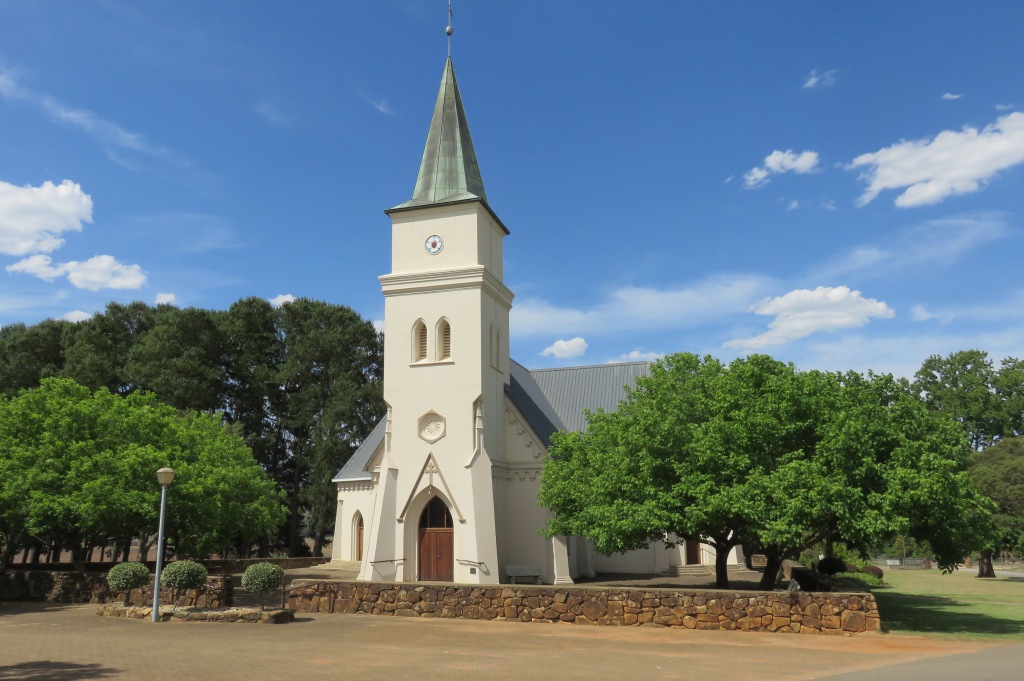 Lüneburg, sometimes written as Luneburg or Luneberg is at 27.3151°S and 30.6178°E at 1146m altitude.
Lüneburg, sometimes written as Luneburg or Luneberg is at 27.3151°S and 30.6178°E at 1146m altitude.
Pre-History
What is meant by pre-history here is the time before the colonisation. A start with the mission stations of the northern Zululand was made in 1860 when the Hermansburg Mission Society superintendent Hardeland paid a visit to King Mpande. He obtained permission from the king to establish mission stations at eNtombe, eNcaka and eMlongavula. eNtombe is near where Braunschweig is now, eNcaba is Lüneburg and eMlongamvula I don't know. Missionaries Prydtz and Moe, plus some colonists: Niebuhr, Rabe, Küsell and Kröger were sent out to establish the stations.
Soon after their arrival some Boers came on horseback and informed them that this is their land. And if the missionaries want to build here they would have to get permission from Wakkerstroom or Lydenburg. The missionaries tried to come to some arrangement with the Boers. At the same time King Mpande and/or Cetshwayo would still exercise their authority over the area. This was done by sending expeditionary forces to collect cattle they needed to feed their army. At one occasion they built a homestead at eNcaka (Lüneburg) as a symbol of their ownership. The Boers promptly came and destroyed it.
As part of the strategy Mpande or Cetchwayo (we don't know who it was, at the time Cetchwayo, the kings son, exercised more and more authority over the kingdom of the Zulus) send a young girl to Chief Thathawe as a gift, but expecting lobola (wedding gift) to be paid in the form of cattle. The tribe could not afford this and in order to escape the wrath of the king they moved off toward Wakkerstroom. The Boers at Wakkerstroom didn't like that and blocked their way. A fight ensued and Chief Thathawe was killed.
On being informed about this the king send in the army to repossess the eNtombe and eNcaka areas. The Boers had to accept that for a while, not having the strength and numbers to defeat a Zulu army.
The argument about who's land it is carried on for a long time until it was settled by a border commission in 1879.
History
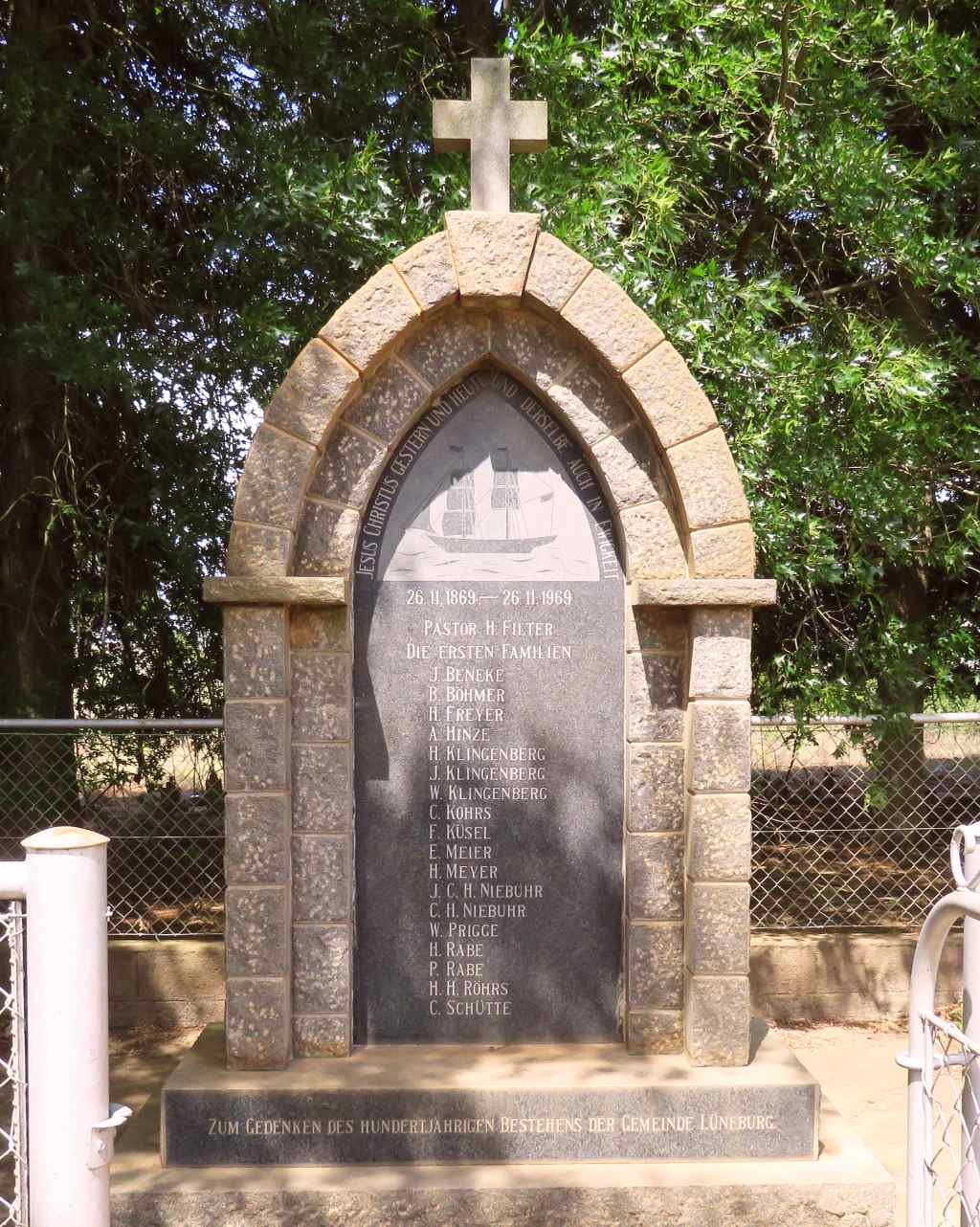 The instructions from the mission society was for the missionaries to go and live amongst the natives, so that they are part of their daily lives and to get a first hand knowledge of their customs and culture. But then the society found it necessary to send out trades men to help the missionaries to build their station. What happened in Lüneburg was that the society ran out of money and couldn't pay the trades people. They started to make a living by cutting down trees in the natural forests, cutting into blanks and sending them off to Durban and Barberton to exchange them for farming requisites. Thus the area around Lüneburg became colonised by people from Germany.
The instructions from the mission society was for the missionaries to go and live amongst the natives, so that they are part of their daily lives and to get a first hand knowledge of their customs and culture. But then the society found it necessary to send out trades men to help the missionaries to build their station. What happened in Lüneburg was that the society ran out of money and couldn't pay the trades people. They started to make a living by cutting down trees in the natural forests, cutting into blanks and sending them off to Durban and Barberton to exchange them for farming requisites. Thus the area around Lüneburg became colonised by people from Germany.
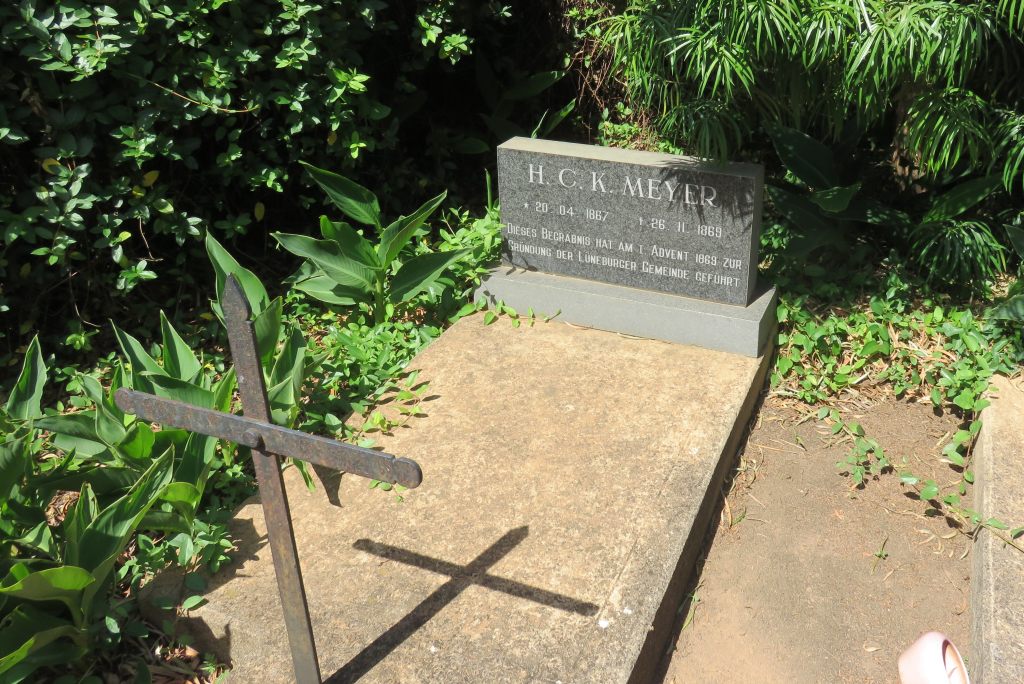 A start was made with forming a congregation of the Lutheran faith when H.Meyer's two year old son died by drowning and had to be buried. A cemetery was laid out which is seen as the beginning of the community. The place was named after the town Lüneburg in Germany from where many of the settlers had originated. Next was to build a church from sod, that is pieces of grass piled on top of each other.
A start was made with forming a congregation of the Lutheran faith when H.Meyer's two year old son died by drowning and had to be buried. A cemetery was laid out which is seen as the beginning of the community. The place was named after the town Lüneburg in Germany from where many of the settlers had originated. Next was to build a church from sod, that is pieces of grass piled on top of each other.
A year later came a school, initially mainly for religious instructions.
Church
When looking at the information board at the cemetery one is informed that the first church was constructed from sod (grass) near where the 100 year monument is now. But talking to Kurt Gevers we were informed that the sod church was at a place just to the left (west) some 400m on the same side of the road. The exact position was pointed out to us. A stone church was later built at a place where the centenary monument is. It was surrounded by a wall so that it can be used as a place of safety. That was done before the Zulu war, at a time when the area was unsafe because of the raids carried out by Mbilisi from 1875 on. The stones from this church and the wall were later used for the wall around the present church. A few stones left behind do mark the place where the church was.
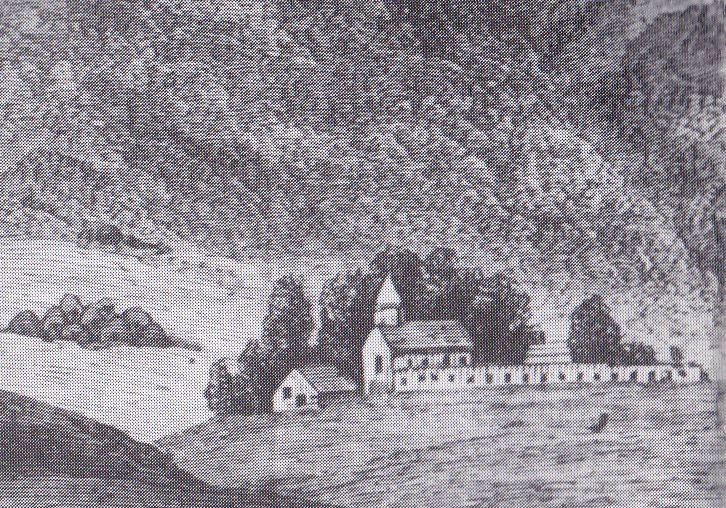 We do have some idea of what this second church looked like, in ref 4 is a sketch from the Illustated London News of May 1879. I have reproduced a part of the picture that shows the church. And look, it had a wall around it.
We do have some idea of what this second church looked like, in ref 4 is a sketch from the Illustated London News of May 1879. I have reproduced a part of the picture that shows the church. And look, it had a wall around it.
As already stated during the Zulu War (1879) this church was turned into a fort for the protection of the women and children. The church/fort was under siege at least once. There is a story around this, told to us by Kurt Gevers who lives in Lüneburg, I cannot vouch for the authenticity of the tale, but it is a nice story worth retelling, I think.
During the Zulu war on one occasion the woman and children had to seek refuge in the church, which had been converted into a fort. In the confusion two of the Küssel girls were left outside. The Zulus had surrounded the place with lots of noise and threads. Under those circumstances they could not open the gate to get them inside. The women were armed, some of the Hollands woman said we must shoot. But the German woman would not hear about it and insisted that they will only shoot once the first assegai lands in the fort. This attack never came and eventually the Zulus withdrew.
Some time after the end of the war the Zulus involved were asked why they didn't attack. The answer was that there were some woman in white dresses and they though these were angles sent to protect the people in the fort.
A new church was build in 1884, a solid and majestic building, still in use today. There is an article in the heritage portal covering this church.
School
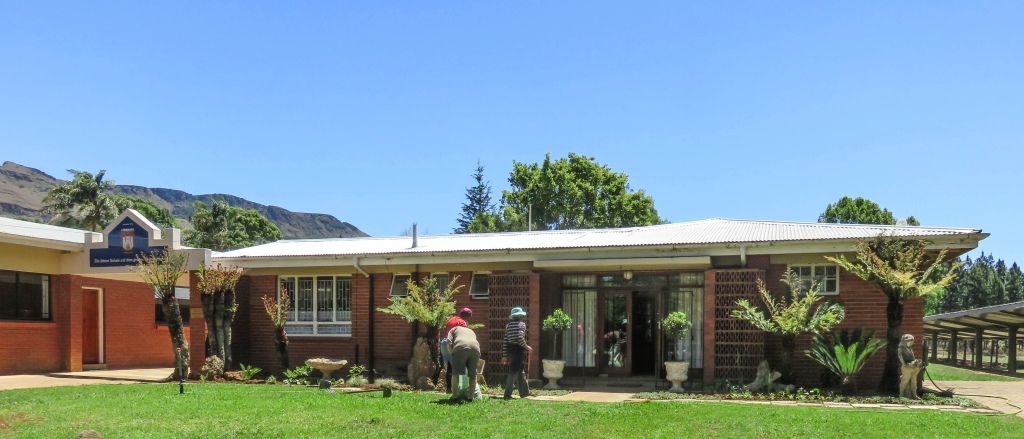
 The Deutsche Schule, the German school, had its beginning in 1870 when the pastor taught the children of the colonists, writing, sums and religion. The language of instruction was, of course, German.
The old school suffered destruction during the Anglo Boer war. But school started again already in 1902 by converting a horse stable to school rooms. This second school was expanded and added onto with time. The building is still standing as 'die Alte Schule', the old school. The rooms are still being used for other purposes. 1966 a completely new school was erected, which is the one shown in the picture.
The language of instruction is still partially German, Afrikaans being the other language. This is to increase the numbers and also because it is now a government school. Using one of the official languages keeps the department of education happy.
The school is still going strong and it also sounds like the department is keeping its nose out of it.
The Deutsche Schule, the German school, had its beginning in 1870 when the pastor taught the children of the colonists, writing, sums and religion. The language of instruction was, of course, German.
The old school suffered destruction during the Anglo Boer war. But school started again already in 1902 by converting a horse stable to school rooms. This second school was expanded and added onto with time. The building is still standing as 'die Alte Schule', the old school. The rooms are still being used for other purposes. 1966 a completely new school was erected, which is the one shown in the picture.
The language of instruction is still partially German, Afrikaans being the other language. This is to increase the numbers and also because it is now a government school. Using one of the official languages keeps the department of education happy.
The school is still going strong and it also sounds like the department is keeping its nose out of it.
cemetery
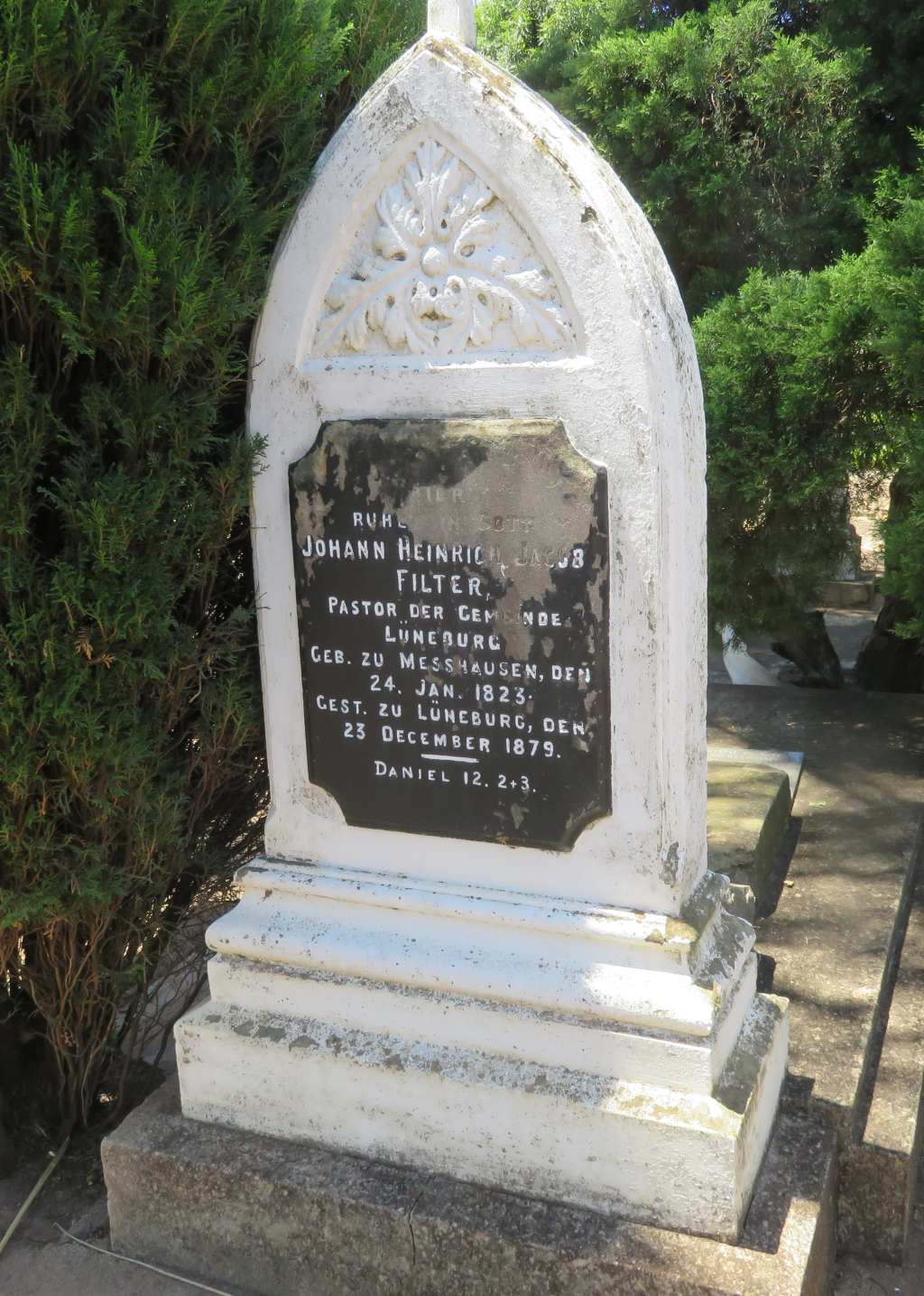 On the other side of the road is the cemetery, actually two cemeteries. There is the German one (although it does contain some non-Germans, I'll come back to this) and on the left are the graves of some local Zulus.
On the other side of the road is the cemetery, actually two cemeteries. There is the German one (although it does contain some non-Germans, I'll come back to this) and on the left are the graves of some local Zulus.
The first grave was that of H.Meyer, see picture and details above. Pastor J.Filter, who was travelling through, held the ceremony and was be-sueded to become the pastor of the Lüneburg community.
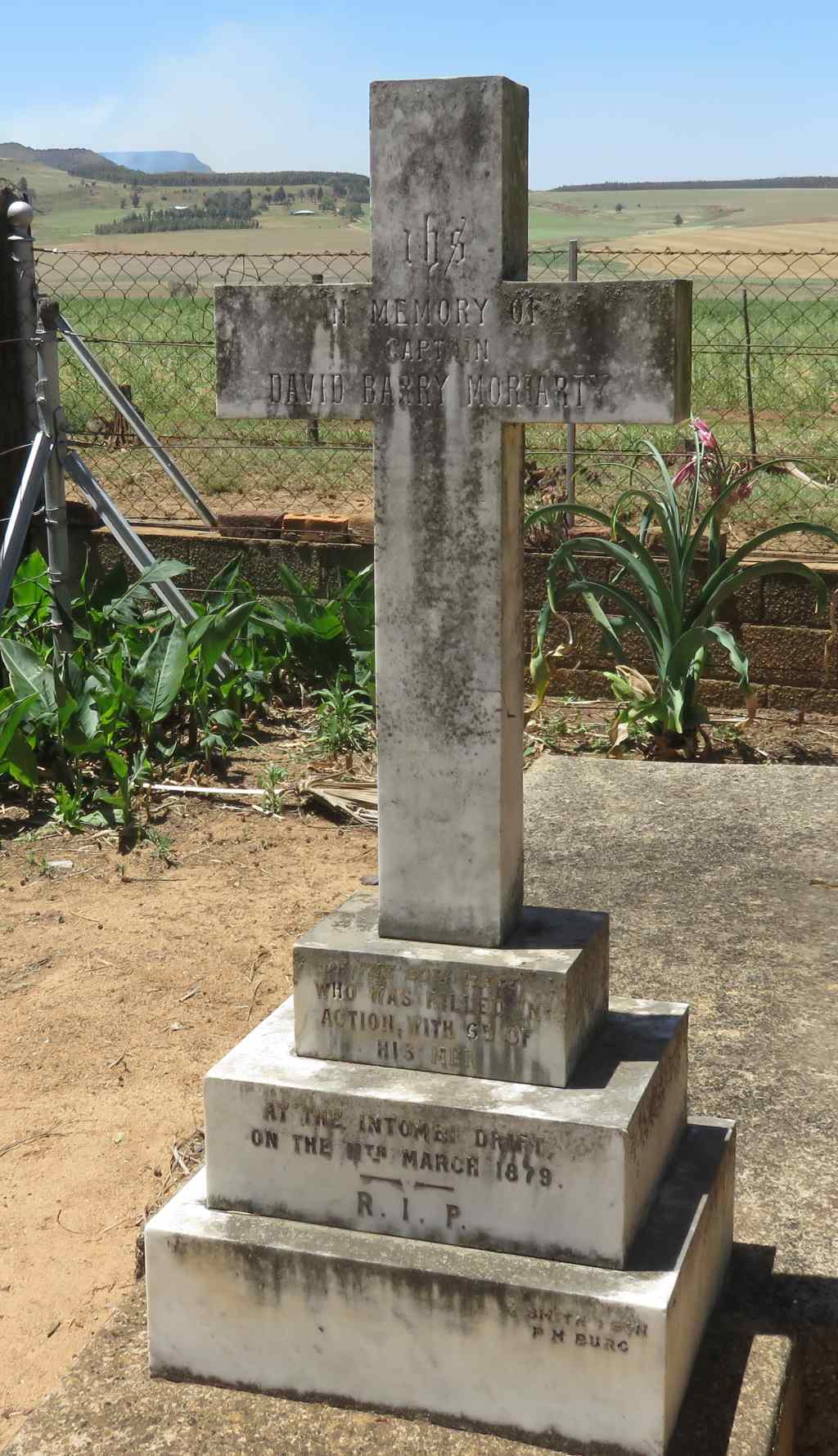 His grave, that of J.Filter, is also in the cemetery, The details on the stone reads: Johann Heinrich Jacob Filter, Pastor der Gemeinde Lüneburg, geb zu Messhausen, den 24 Jan 1823, gest zu Lüneburg den 23 December 1879. Just for interest I looked up Messhausen, it is in the south of Germany, near lake Constance. This is unusual, most of the early missionaries and colonists came from the northern parts of Germany.
His grave, that of J.Filter, is also in the cemetery, The details on the stone reads: Johann Heinrich Jacob Filter, Pastor der Gemeinde Lüneburg, geb zu Messhausen, den 24 Jan 1823, gest zu Lüneburg den 23 December 1879. Just for interest I looked up Messhausen, it is in the south of Germany, near lake Constance. This is unusual, most of the early missionaries and colonists came from the northern parts of Germany.
The non-German graves are the ones from the battle at Ntombe drift in 1879, see the details of the battle on the Braunschweig page. It was the officers that were buried here, most prominent Captain DB Moriarty, the officer in charge, see picture. The inscription reads: ihs in memory of captain David Barry Moriarty, of the 80th Regt, who was killed in action with 65 of his men, at the Intombi drift on the 11th March 1879, R.I.P. Note the mistake with the date, it was the 12th when the battle took place. The other two names that I can make out are William Ingram Cobbin CIV/SURG (I presume that means surgeon) and J.Whittington, CIV/COND (I don't know what that means, a search on the Internet drew a blank.
Fort Clery
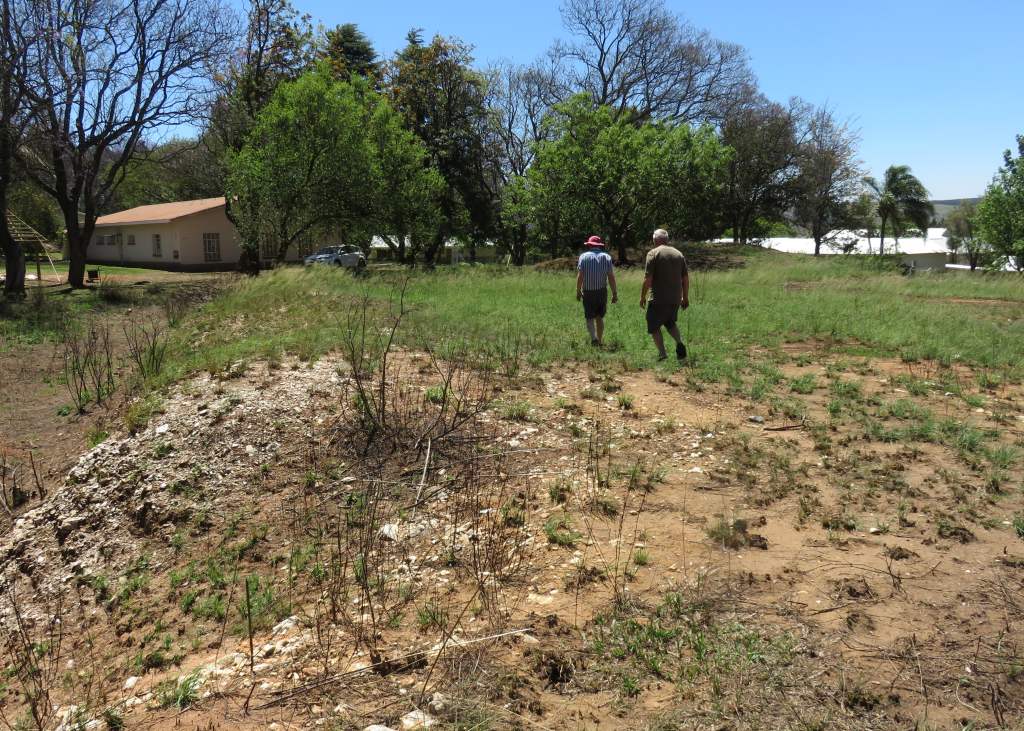
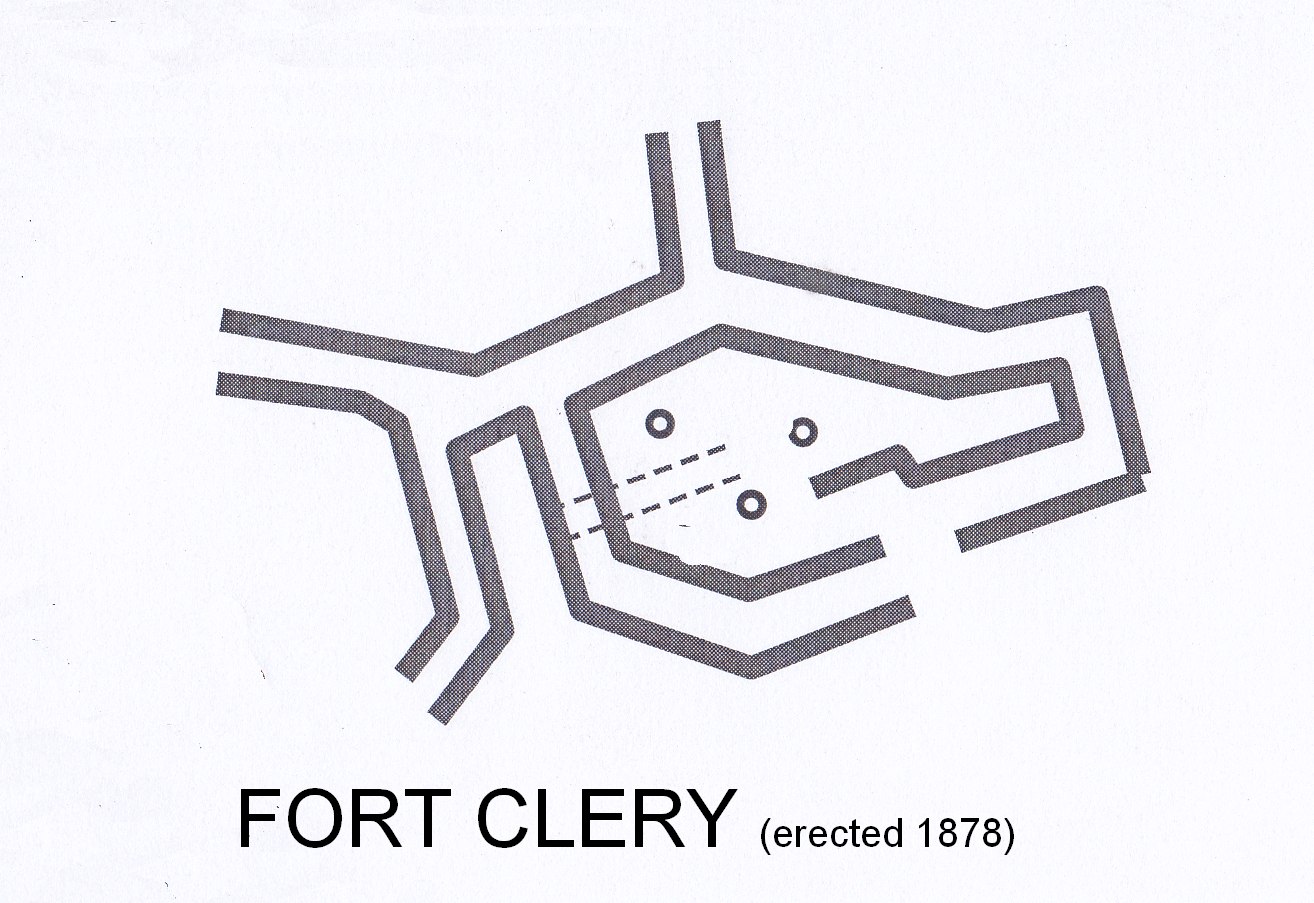 Not much can be seen of the details of this fort, it is just a heap of soil and rubble now. The sketch on the right is roughly what it looked like It was a fort built by the British before the Zulu war in 1878. Its main purpose was to store supplies for the forces in the field fighting the Zulus.
Not much can be seen of the details of this fort, it is just a heap of soil and rubble now. The sketch on the right is roughly what it looked like It was a fort built by the British before the Zulu war in 1878. Its main purpose was to store supplies for the forces in the field fighting the Zulus.
Supplies came mainly from Lydenburg where the British had finished fighting the Sekunkuni war. Delivered was using convoys of wagons, it was the attack on one of these wagon trains that was the battle of the Ntombe river, see under Braunschweig.
The Filter monument
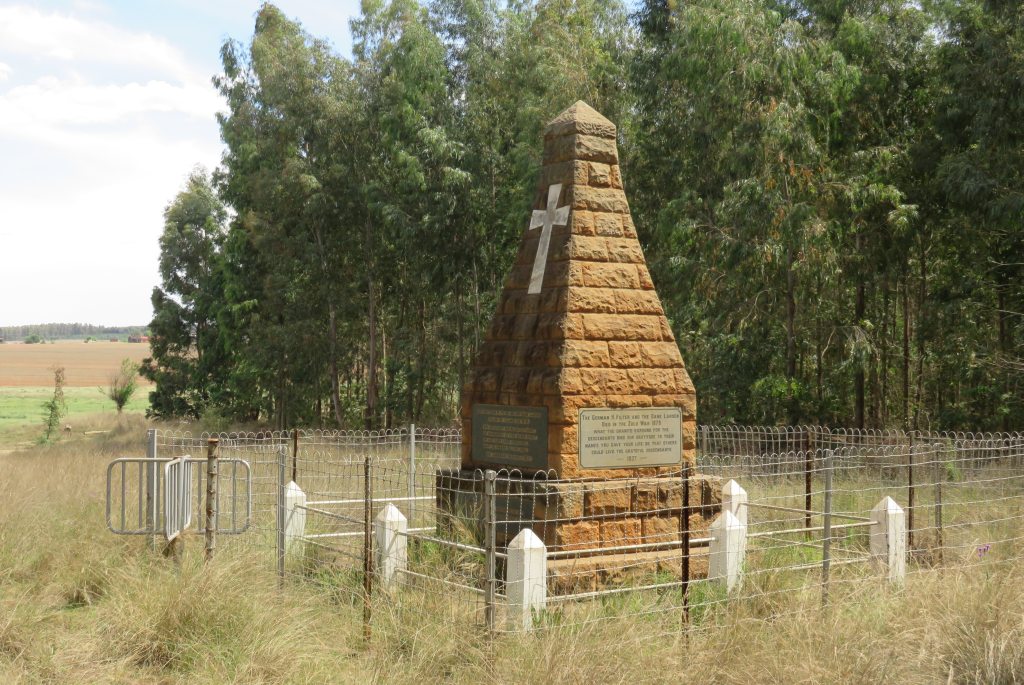 Next to the road between Lüneburg and Braunschweig is a monument, position: 27.2989°S and 30.672°E. The text on the English plague reads as follow:
Next to the road between Lüneburg and Braunschweig is a monument, position: 27.2989°S and 30.672°E. The text on the English plague reads as follow: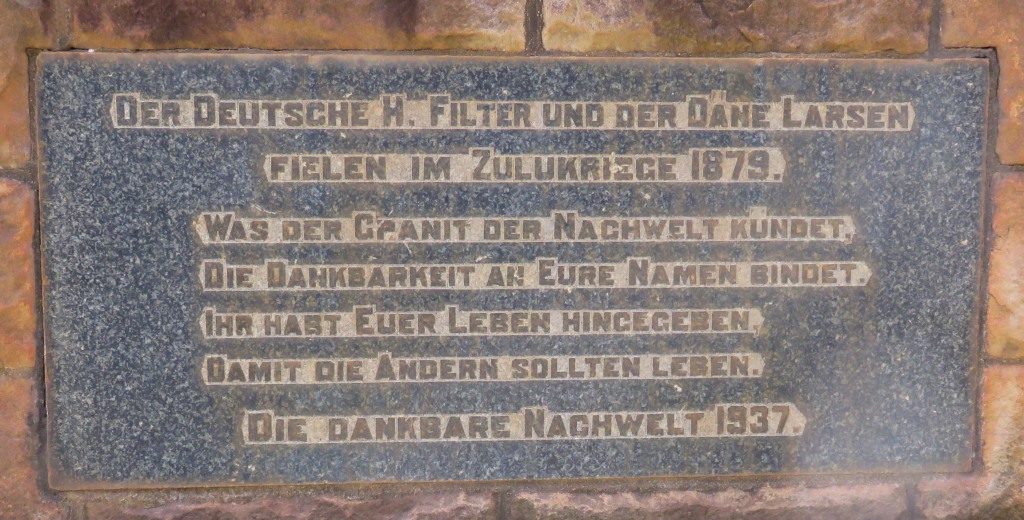 The German H.Filter and the Dane Larsen
The German H.Filter and the Dane Larsen
died in the Zulu War 1879
what the granite expound for the
descendants bind our gratitude to their
names you gave your life so that others
could live. The grateful descendants
-1937-
This translation from German is a bit stilted, but I have to admit I would not have been able to do it any better, for some of the words it's difficult to find an equivalent in English.
The background to this, the father of H.Filter was Jakob Filter, the missionary stationed at Lüneburg. J.Filter did have a somewhat uneasy relationship with the Zulus and wished 'the British would take over to bring a war in which the British would be victorious thereby Christianity, education, law and order will be established, or the Zulus would be victorious, thereby heathenism, tyranny, and barbarism would prevail.' A quote found in Ref.2 from his communications with the Hermannsburg Mission Society (Germany). The British army occupied the area during the Zulu war of 1879 and built a fort at Lüneburg. J.Filter allowed his son to work with the British to do reconnaissance. During one of those missions he was captured and killed by the Zulus.
I have found no information about the Dane Larsen, it is believed that he was with H.Filter when they were captured. And why a Dane, studying the history of the Hermannsburg Mission Society I have come across a piece of information that says some Danish missionaries had joined the society
A more detailed account of events involving H.Filter from Rev 2. Prince Mbilini, a son of the Swazi king Mswati, was marauding with his horde of warriors through the area, stealing and pillaging. And that because he had been overlooked to become the new king on his father's death. He made his 'home' in the northern parts of Zululand, in the area around Lüneburg and made a nuisance of himself. The Zulu King Cetshwayo actually ordered him to be captured and killed. But somehow when the Zulu war came he became an ally of King Cetshwayo.
The sources don't say where and when, H.Filter shot and wounded Mbilini who later died of his wounds.
References
Ref 1.: Standard Encyclopedia of Southern Africa, Nasou Limited, 1974
Ref 2.: FROM THE LÜNEBURGER HEIDE TO NORTHERN ZULULAND A HISTORY OF THE ENCOUNTER BETWEEN THE SETTLERS,
THE HERMANNSBURG MISSIONARIES, THE AMAKHOSI AND THEIR PEOPLE, WITH SPECIAL REFERENCE TO FOUR MISSION STATIONS IN NORTHERN
ZULULAND (1860-1913), Submitted in fulfilment of the requirements for the Degree of Master of Theology in the School of Theology
University of Natal Pietermaritzburg, December 2002
Ref 3.: Lutherans, Germans:Hermannsburgers, Natalia 22 (1992), H-J. Oschadleus (enter the title as a search term to find the article)
Ref 4.:'Lüneburg 1869-1992, a booklet available at the Deutsche Schule
Just a comment to Ref 2, FROM THE LÜNEBURGER HEIDE TO NORTHERN ZULULAND. It is a master thesis prepared by Prince Bongani Kashelemba Zulu. The author has gone into lots of details, it is well written and very informative. I actually think its worth a PhD, but then I am not a professor.
And what I value most is that the theses is written from a Zulu perspective. History of South Africa has mainly been written by pink people and has thus, even if unindented, a white bias. A work like this written by a Zulu (I presume) is thus a very welcome addition to the body of history of this country.